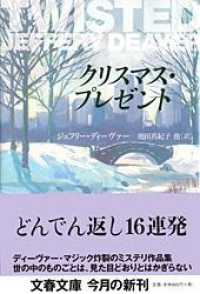- ホーム
- > 洋書
- > 英文書
- > History / World
Full Description
What is the role of aesthetic expression in responding to discrimination, tragedy, violence, even genocide? How does gender shape responses to both literal and structural violence, including implicit linguistic, familial, and cultural violence? How might writing or other works of art contribute to healing? Art from Trauma: Genocide and Healing beyond Rwanda explores the possibility of art as therapeutic, capable of implementation by mental health practitioners crafting mental health policy in Rwanda.
This anthology of scholarly, personal, and hybrid essays was inspired by scholar and activist Chantal Kalisa (1965-2015). At the commemoration of the nineteenth anniversary of the genocide in Rwanda, organized by the Rwandan Embassy in Washington DC, Kalisa gave a presentation, "Who Speaks for the Survivors of the Genocide against Tutsi?" Kalisa devoted her energy to giving expression to those whose voices had been distorted or silenced. The essays in this anthology address how the production and experience of visual, dramatic, cinematic, and musical arts, in addition to literary arts, contribute to healing from the trauma of mass violence, offering preliminary responses to questions like Kalisa's and honoring her by continuing the dialogue in which she participated with such passion, sharing the work of scholars and colleagues in genocide studies, gender studies, and francophone literatures.
Contents
List of Illustrations
Foreword, by Patricia A. Simpson
Acknowledgments
Introduction, by Rangira BÉa Gallimore and Gerise Herndon
Part I. In Memoriam: Lessons Learned from Chantal Kalisa
1. Baby Steps
Margaret Jacobs
2. Speaking Nearby Genocide
Gerise Herndon
3. Chantal's Voice: A Guiding Light
Natalia Ledford
4. Bittersweet Realities: Field Research, Human Rights, and Questioning Intentions
Laura Roost and Ryan Lowry, with Patrice McMahon
5. Memory, Language, and Healing
Isabel VelÁzquez
Part II. Performing Arts and Healing from the Genocide against the Tutsi in Rwanda
6. Theater and the Rwandan Genocide
Chantal Kalisa
7. Ingoma Nshya: Forbidden Fruit Brings Healing and Empowerment to Rwandan Female Drummers
Rangira BÉa Gallimore
Part III. Visualizing Violence, Silence, and Trauma
8. The Films of Kivu Ruhorahoza: Staging a New Sense of Direction?
Odile Cazenave and Patricia-Pia CÉlÉrier
9. HÉla Ammar: Art and Beyond
Anna Rocca
10. Filming with Orphans of the Genocide: A Transformative Dialogue through a Double-Lens Approach
Alexandre Dauge-Roth
11. Art for Teaching and Art for Surviving: From the Holocaust to Healing
Eileen M. Angelini and Heather E. Connell
Part IV. Narrating Atrocities and Dealing with Trauma
12. Gender-Based Violence in Monique Ilboudo's Fiction
Nicki Hitchcott
13. Narrating Itsembabwoko and the Quest for Empathy
Josias Semujanga
14. "Lay Down Body, Lay Down": Mitigating Transgenerational Trauma through Spirituality in Jewell Parker Rhodes's Magic City
Kalenda Eaton
Part V. Scripting Self and Healing in Women's Narratives
15. Womenʼs Friendship in Exile: Healing in the Epistolary Correspondence between Zenobia CamprubÍ and Pilar de Zubiaurre
Iker GonzÁlez-Allende
16. Preserving Memories, Celebrating Lives: War, Motherhood, and Grief in Scholastique Mukasonga's La femme aux pieds nus
Marzia Caporale
List of Contributors
Index








